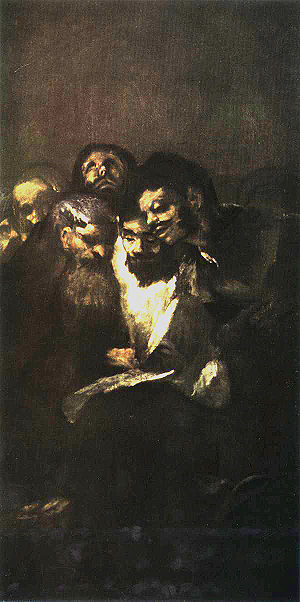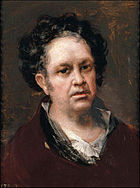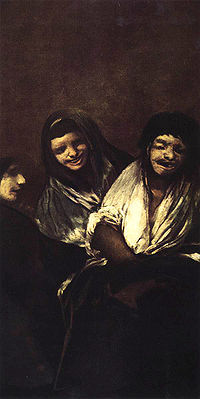- Men Reading
-
 Men Reading, 1821–1823. 125.3cm x 65.2cm, Oil on gesso transferred to linen. Museo del Prado, Madrid
Men Reading, 1821–1823. 125.3cm x 65.2cm, Oil on gesso transferred to linen. Museo del Prado, Madrid
Men Reading or The Reading (Spanish: La Lectura) or Politicians are names given[1] to a fresco painting likely completed between 1820–1823[2] by the Spanish artist Francisco Goya. It is one of Goya's 14 "Black Paintings" (Pinturas negras) painted late in his life when, living alone in physical pain, spiritual torment and disillusionment with the political direction of Spain, he painted 14 bleak, agonised frescoes onto the walls of the Quinta del sordo (House of the deaf man), the house he was living in alone outside Madrid.
With the others in the series, it was transferred to canvas in 1873-74 under the supervision of Salvador Martínez Cubells, a curator at the Museo del Prado. The owner, Baron Emile d'Erlanger, donated the canvases to the Spanish state in 1881, and they are now on display at the Prado.[3]
Contents
Description
Men Reading shows a group of six men huddled together reading a printed page held in the lap of a seated central figure. Although it is not known for certain, they are often thought to be politicians reading, and passing comments on, a newspaper article about themselves. Goya most likely placed the work on a smaller wall of the first floor of the Quinto, next to its companion piece Women Laughing and opposite The Dog and Two Old Men Eating Soup.[4]
X-ray reveals that the image was dramatically altered before Goya settled on what is now on the canvas. At some stage a landscape in the background showed a mounted rider. The central figure in white at one point had large horns, or possibly bird wings, seemingly growing out of his head.[5] From studying the x-rays art historian Carmen Garrido discovered that the center of the image contained a large white lead impasto beginning at the head of the man looking upwards, and that "both the part on top of the impasto and that which is level with the rest of the painting are identical, and have neither the texture nor the normal structure of the authentic brushstrokes of the painter."[5]
Thematically and stylistically it shares characteristics with another work from the "Black Paintings" series, Women Laughing. Both are vertical rather than horizontal and smaller in scale than the other works. Both are thematically less dark than the other works in the series, although they are chromatically darker.[6] Both are lit by identical light falling from the upper left of the pictorial space. Women Laughing shows two hags mocking a man in the act of masturbating, while in Men reading, according to writer Francisco-Xavier de Salas Bosch, "the incessant talk of the politicians...was perhaps, in Goya’s eyes, as sterile as the solitary pleasure which the women are making fun of."[7]
References
- ^ Goya did not title any of the works in this series, the name come variously from his children, art historians, restorers, curators
- ^ Licht, 159
- ^ Hughes, 16–17
- ^ Junquera, 43
- ^ a b Junquera, 78
- ^ Fernández, G. "Goya: The Black Paintings". theartwolf.com, August 2006. Retrieved 15 January 2010.
- ^ de Salas Bosch
Bibliography
- de Salas Bosch, Francisco-Xavier. Goya. NY:Mayflower Books, 1978. ISBN 0-2897-0887-7
- Junquera, Juan José. The Black Paintings of Goya. London: Scala Publishers, 2008. ISBN 1-8575-9273-5
- Hughes, Robert. Goya. New York: Alfred A. Knopf, 2004. ISBN 0-3945-8028-1
- Licht, Fred. Goya: The Origins of the Modern temper in Art. Universe Books, 1979. ISBN 0-87663-294-0
External links
Francisco Goya List of works Paintings Blind Guitarist (1778) • Christ Crucified (1780) • Maria Teresa de Borbon y Vallabriga (1783) • Spring (or The Flower Girls) (1786–1787) • The Swing (1787) • St Francis Borja at the Deathbed of an Impenitent (1788) • Manuel Osorio de Zuniga (c. 1788) • Witches' Sabbath (1789) • Self-portrait (c. 1790–1795) • Little Giants (1791–1792) • Portrait of Mariana Waldstein (c. 1792) • Strolling Players (1793) • Yard with Lunatics (1793–1794) • Marquesa de la Solana (c. 1794–1795) • Duchess of Alba (1797) • Self-Portrait with Eyeglasses (1797) • The Bewitched Man (1797-1798) • The Devil's Lamp (1797-1798) • Witches' Flight (1797-98) • Charles IV in his Hunting Clothes (1799) • Countess of Chinchon (1800) • La maja desnuda • Charles IV of Spain and His Family (1800–1801) • La maja vestida • Bartolome Sureda y Miserol (c. 1803–1804) • Portrait of Doña Isabel de Porcel (1804–1805) • Portrait of Francisca Sabasa García (1804-1808) • Doña Teresa Sureda (c. 1805) • The Colossus (1808–1812; attribution debated) • Majas on a Balcony (c. 1808–1812) • Time (c. 1810–1812) • Prison Interior (c. 1810–1814) • The Second of May 1808 (1814) • The Third of May 1808 (1814) • The Junta of the Philippines (1815) • The Madhouse (1812-1819) • The Inquisition Tribunal (1812-1819) • The Burial of the Sardine (c. 1816) • A Procession of Flagellants (c. 1816) • The Forge (c. 1817) • The Giant (1818) • Self-portrait with Dr Arrieta (1820) • The Milkmaid of Bordeaux (1825–1827)
Tapestry cartoonsThe Parasol (c. 1777) • Blind man's bluff (1789)Saturn Devouring His Son • Judith and Holofernes • Witches' Sabbath • A Pilgrimage to San Isidro • La Leocadia • Two Old Men • Men Reading • Man Mocked by Two Women • Fight with Cudgels • Procession of the Holy Office • Atropos • Asmodea • Two Old Men Eating Soup • The Dog

Etchings The Sleep of Reason Produces Monsters (1797–1798) • What a sacrifice! (1797–1798) • They say yes and give their hand to the first comer (1797–1798) • Que se la llevaron! (1797–1798) • You who cannot (1797–1798)TauromaquiaUnfortunate events in the front seats of the ring of Madrid, and the death of the Mayor of Torrejón (1815–1816)Categories:- 1820s paintings
- Francisco Goya paintings
Wikimedia Foundation. 2010.

